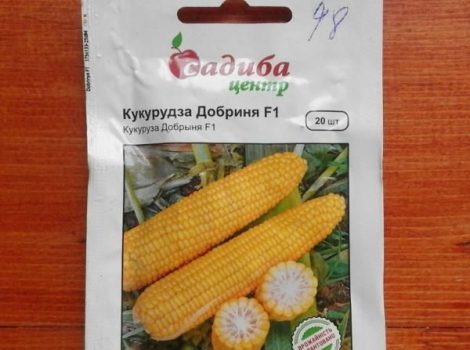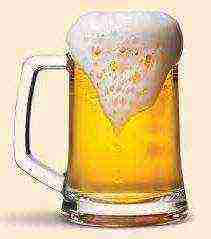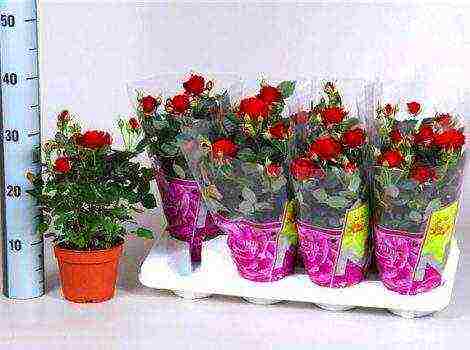Content [show]
On the plots of gardening enthusiasts, it is customary to grow at least one honeysuckle bush. And true admirers of this culture know that there are various varieties that differ in taste. In addition, gardeners know that plants belonging to different varieties can influence each other's yield. Therefore, it is not surprising that several specimens of this wonderful shrub can grow in their garden.
General description of the plant
Many varieties of honeysuckle are unpretentious, frost-resistant. The plant does not require painstaking care. Basically, it consists in pruning drying out branches, loosening the soil under and around the bush, removing weeds and feeding. Honeysuckle bushes respond positively to abundant watering, and do not tolerate drought well. Loosening of the soil should not be carried out to a great depth, since the roots of the plant are located close to the surface.

The beginning of flowering dates back to around mid-May - this largely depends on the weather and the region where the crop is grown. In the spring, the bush is covered with fragrant flowers. They attract a large number of insects, mainly bees, bumblebees, and flies. It is thanks to their visits that the bush is pollinated. It must be remembered that there are also self-fruitless varieties of honeysuckle, for pollination of which the presence of a plant of another variety is necessary on the site. Flowers are able to withstand a drop in air temperature to minus 5 - 7 degrees.
Reproduction of honeysuckle
The plant does not grow. Reproduction takes place by rooting annual shoots, cuttings, as well as green cuttings. The methods of obtaining planting material are similar to those used for the propagation of gooseberries and currants. Sometimes gardeners use the seed method of propagation of honeysuckle, which is considered to be the most laborious and troublesome.
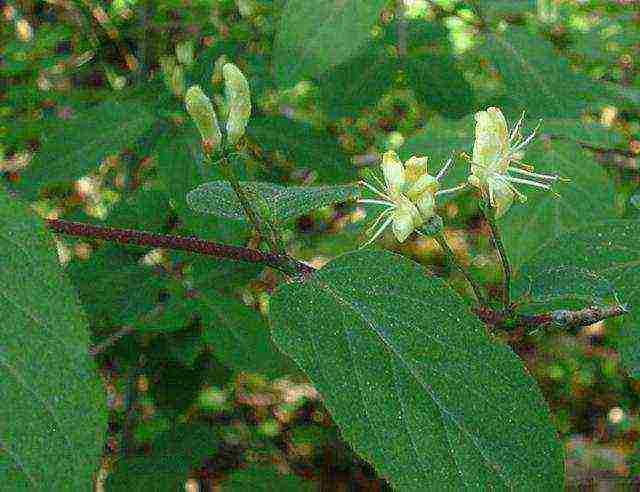
The plant should be planted in such a way that it is under the cover of the crowns of taller plants. Choosing such a planting site helps to achieve the best honeysuckle harvest. Its fruits, being in direct sunlight, can become smaller.
Honeysuckle has an attractive crown shape; the bush can become a real decoration of the gardening site during the entire growing season.
Fruiting
In the third or fourth year after planting annual shoots, honeysuckle begins to yield.
Fruits ripen very early (in the first half of June), even before strawberries or any other berries appear in the garden. This is undoubtedly a great advantage that honeysuckle has. Sweet varieties of berries ripen at an earlier date. But they are distinguished by the fact that when they reach maturity, the fruits quickly fall off. This is one of the negative properties of certain varieties of honeysuckle. Gardeners have found a way to harvest crops without loss. To do this, during the period of active ripening of honeysuckle berries, spread a film, paper or some other material under the bush, from which you can easily collect the sprinkled fruits later.
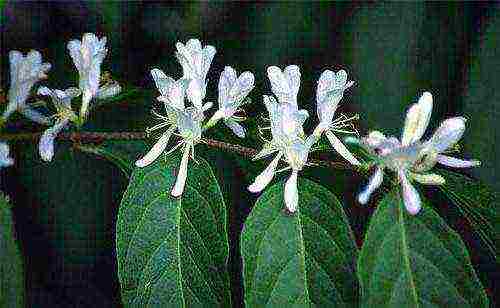
Berries are very rich in active substances, sugars, acids, vitamins, which have a beneficial effect on the functioning of various systems of the human body. They can be consumed fresh and processed.
There are many recipes for cooking dishes using honeysuckle. It can be prepared for the winter in the form of freezing, jam, jam, compote, juice. The color and taste of the jam is very similar to cherry jam. Honeysuckle juice is used as a food coloring.
Honeysuckle varieties
The popularity of the shrub increases from year to year. That is why, having received its beginning 40 years ago, breeding work is carried out very actively today. Today, there are many varieties and forms that honeysuckle can have. The best plant varieties are offered by many fruit nurseries and research institutes, so it is not difficult to acquire a specimen of interest to a gardener.
All existing crop varieties can be divided into groups for different reasons. Taking into account the ripening time of the berry crop, early-ripening, mid-ripening and late-ripening species can be distinguished.
Productivity, taste of berries, their size, shape, color, conditions for growing a bush - a list of distinctive properties that different varieties of honeysuckle have.
Depending on belonging to a particular variety, the berries can have different shades of purple, sometimes approaching black. A distinctive feature is a kind of bluish bloom that covers the honeysuckle fruits.
The shape of the berries is very diverse - oval, cylindrical, round-oval, fusiform, elongated or with a truncated end. Large-fruited varieties of honeysuckle can produce berries up to 2 cm long and 8 mm wide.
Taste characteristics are one of the main indicators of the variety. There are sweet, sour-sweet berries, with and without bitterness, and many other honeysuckle flavors are also known.
What determines the choice of shrub variety
Before deciding to plant a plant in the garden, it is advisable to familiarize yourself with the peculiarities of the variety, its distinctive characteristics. This will avoid disappointment when the fruits appear or the bush reaches the size of an adult plant.
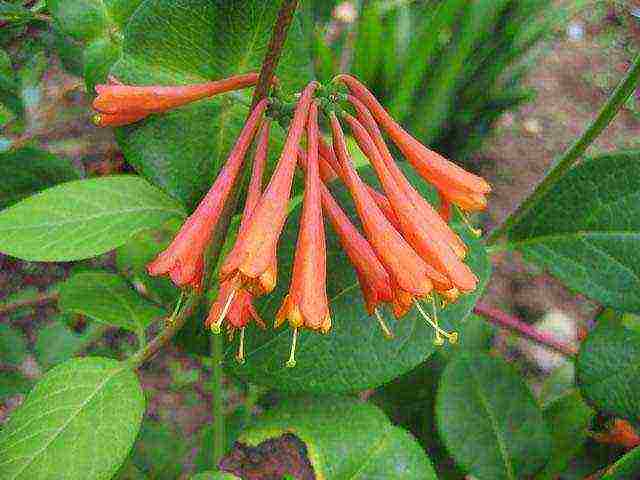
For some gardeners, not only the taste of the berries matters, but also the yield of the variety, which is also different. It ranges from 500 grams to 4 kg per bush.
It is necessary to take into account the size and shape of the honeysuckle bush in order to choose the right place for growing on the site. The bush usually reaches its maximum size after 6 - 10 years of growth.
A certain variety must be chosen and taking into account the region where the crop will be cultivated. For example, varieties of honeysuckle for the Moscow region differ from those that will grow well in the northern regions of the country.
Tomsk varieties
The forms developed in the NIISS of the city of Tomsk are very popular.
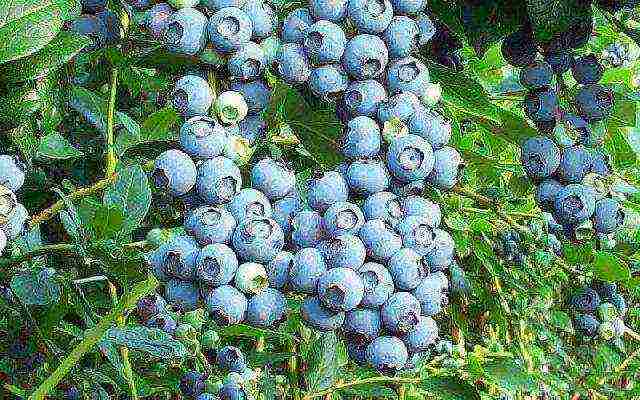
One of these varieties is the Bakchar giant. Honeysuckle has a high yield. The fruits have the shape of an elongated cylinder, the average size of which reaches 4 cm, and the weight is 2 grams. The dense skin allows keeping the berries fresh for a long time.For the same reason, transportation of the crop is allowed and the ability to avoid damage to the berries. The variety is loved by many for the pleasant sweet and sour taste of the fruit. The index of their crumbling after ripening is average. A powerful bush up to 1.9 meters high has an oval crown with sparse branches. Variety Bakcharsky giant – honeysuckle, which is recommended for cultivation in different regions of Russia. The plant belongs to the group of self-infertile forms. Varieties Nymph, Memory of Gidzyuk, Amphora, Pavlovskaya, Lazurnaya are pollinators for the Bakchar giant.
The best Tomsk varieties include Pride Bakchara, Silginka, Parabelskaya and many others.
Honeysuckle varieties for the Moscow region
The forms of the plant, bred for cultivation in the conditions of the Moscow Region and the Central Strip of Russia, are widely known.
The variety Kingfisher with a medium early ripening period appeared in the breeding farms of the Moscow Region. A powerful bush, having an oval crown shape, can reach 2.1 m in height. A distinctive feature of the variety is its high yield. The dense skin of the berries allows you to store them after picking. The fruits have an unusual round-oval shape with a blunt top. Their size reaches 1.6 cm, with a mass of 1.1 g. The berries are unusually pleasant to the taste - they are sweet with a slight sourness.
Honeysuckle varieties such as Kuminovka, Moskovskaya-23 and many others are also suitable for growing in the Moscow region.
Varieties for the Ural region
Honeysuckle varieties for the Urals should be distinguished primarily by their high frost resistance. Severe winters with sharp temperature changes should not adversely affect the growth and development of the plant.
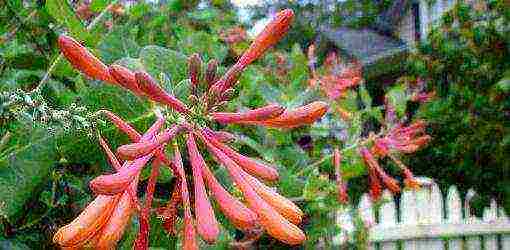
The high-yielding variety Elizaveta with an average ripening period was bred in the city of Chelyabinsk, taking into account all the climatic conditions of the region. A plant with a slightly spreading crown can reach a height of 2.4 m. Fruits are oval, 1.6 cm in size, weighing 1.2 g, have a surprisingly sweet taste and dense skin.
On the sites of the Ural gardeners, you can also find such varieties of honeysuckle as Lenita, Bazhovskaya, Volshebnitsa and others.
Self-infertile varieties
Many plants during the pollination period must interact with other species to obtain a good harvest. Otherwise, the harvest will be minimized or not at all. In other words, the plant requires a pollinator, and the choice will depend on which variety is being considered.
Honeysuckle Nymph, for example, prefers that varieties such as Pavlovskaya, Amphora, Lazurnaya, Chosen One grow on the site besides her.
For the convenience of gardeners, the sale of honeysuckle seedlings in nurseries is made not by single specimens, but by a pair or group of plants. It is not worth neglecting such an offer when buying planting material, since the harvest of berries will directly depend on the selection of varieties.
Decorative forms
Besides edible varieties of honeysuckle, its decorative forms are known. It is to such a variety that Tatarskaya honeysuckle belongs.

The plant gained its distribution due to its unpretentiousness, the ability of shoots to grow rapidly. In addition, Tatarskaya honeysuckle blooms beautifully in the spring for a whole month. The petals can be in different shades of color - from dark pink to white. And in the fall, the bushes are decorated with bright red or yellow berries. In addition, the densely growing branches have a large number of leaves, which are also very attractive. But the plant has one big drawback - its fruits are not only inedible because of the bitter taste, but they are also poisonous.
Due to its ability to grow even in conditions of high air pollution, Tatarskaya honeysuckle is used as a species for landscaping city streets, parks, squares.
The plant is also found in natural conditions, forming dense thickets. In some regions of the country, the shrub grows in the undergrowth of deciduous forests.
Instead of a conclusion
The varieties of honeysuckle described above are not limited to the above list. Breeders have more than a dozen forms of this useful plant. Their work on improving, changing the varieties of honeysuckle does not stop. Its new forms will continue to delight amateur gardeners.
Honeysuckle is a fairly popular plant in our country. There are different varieties of this berry culture - they can be both fruit and decorative. The ripening time, the degree of sweetness of the fruit and other characteristics differ.
Description of varieties of honeysuckle
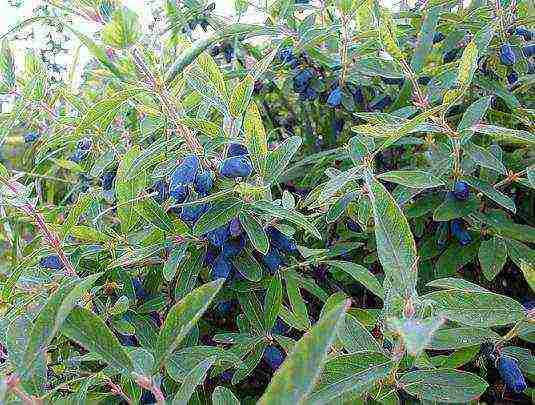
Honeysuckle varieties
Honeysuckle differs in terms of fruit ripening. On June 12-16, early ripening varieties begin to bear fruit, such as Gzhel early, Bakcharskaya, Lebedushka, Dlinnoplodnaya, Morena, Kapel, Dolphin, Fortuna, Selena, etc.
In the period from 17th to 22nd June, berries are harvested with a medium ripening period. This category includes the varieties Zarnitsa, Ivushka, Volkhova, Kuminovka, Dymka, Berel, Vasyugan, Gerda, Gzhelka, Goryanka, Bakcharsky giant, Cinderella.
At the end of June (23-30), late-ripening honeysuckle bears fruit. Here you can distinguish such varieties as: Pavlovskaya, Lakomka, Kingfisher, Amphora, Gzhel late, Chosen, Bazhovskaya, Dessertnaya, Nymph, Chernichka.
In addition to the timing of ripening, such a factor as the height of the plants is important. Bushes up to one and a half meters high are called stunted. This category includes varieties: Nizhegorodskaya early, Gzhelskaya late, Omega, Lakomka, Violet, Gerda, Julia.
The average height is considered to be up to two meters. Varieties that meet this parameter: Shahinya, Gzhelka, Kubyshka, Princess Diana, Kingfisher, Tomichka.
Plants with a height of more than two meters are considered tall (this includes such varieties as the Blue Spindle, Viliga, Volkhova, Nymph).
Honeysuckle varieties: recommendations by region
In the Moscow region and in the Central Russia, varieties such as Moskovskaya-23, Kingfisher, Kuminovka are grown. They tolerate the continental climate of temperate latitudes well (moderately frosty winters and warm, humid summers).
Volshebnitsa, Elizaveta, Lenita, Bazhovskaya, Izuminka, Dlinnoplodnaya, Chernichka, Sineglazka are considered successful varieties for the Ural region. All of them have high frost resistance. Low-growing plants are most preferred.
Siberian varieties: Sibiryachka, Cinderella, In Memory of Kuminov, Selena, Kamchadalka, Pride of Bakchar, Narymskaya, In Memory of Gidzyuk, Tomichka, Vasyugan, Lazurnaya, Berel, Sirius, Sinilga, Roxana.
The varieties recommended for cultivation in the coastal region of Russia: Dolphin, Golubinka, Goryanka, Forget-me-not. They are adapted to the conditions of this region - for long springs, cold dry winters, warm humid summers.
Harvest varieties of honeysuckle
From two or more kilograms of berries from each bush, they give such varieties as Viliga, Souvenir, Kuminovka, Lakomka, Shahinya, Cinderella.
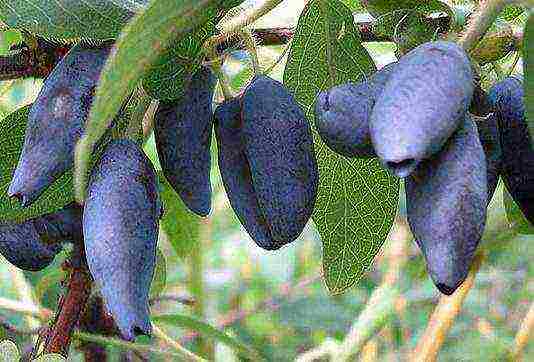
Honeysuckle variety Kamchadalka
The Kamchadalka variety is very famous. The plant gives large yields - 2.7-3.5 kg from each bush. It is characterized by good frost resistance and medium ripening times. The height of the bush does not exceed one and a half meters. The shape of the crown is conical. The plant looks beautiful in the garden. It is afraid of temperature changes, so it is grown in a temperate climate. The berries of this variety are large, with a thin skin and very delicate pulp (the average length of the berries is 2.7 cm).
The best varieties of honeysuckle
The best varieties are those that are distinguished by their large berry size, high yield, and good taste characteristics. The category of the best and most popular varieties includes Bakcharskaya, Silginka, Parabelskaya, Kingfisher, Veliga, Violet, Kuminovka, Laura, Slavyanka.
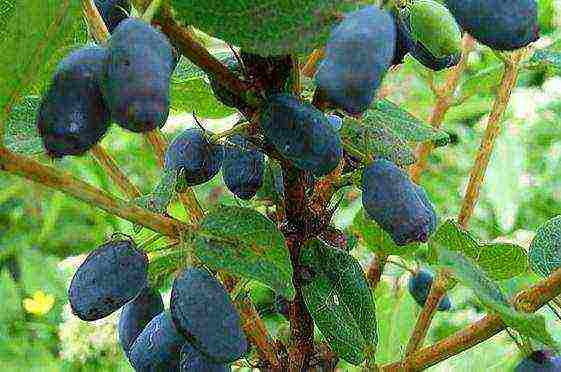
Morena honeysuckle variety
The Morena variety is widely known. A bush with a rounded crown has an average height. The shape of the berries is cylindrical. The skin is covered with a waxy coating. The average berry length is 2.8 cm (weight - 1-1.2 g).The peel of the berries has a high density, which allows you to transport the crop with virtually no loss. Ripening period is average.
Honeysuckle: large-fruited varieties
Large varieties of honeysuckle produce fruits, the weight of which varies within 1.4-2.7 g. Popular varieties: Neosypayuschaya, Sladkoplodnaya, Tatiana, Alena, Polina.
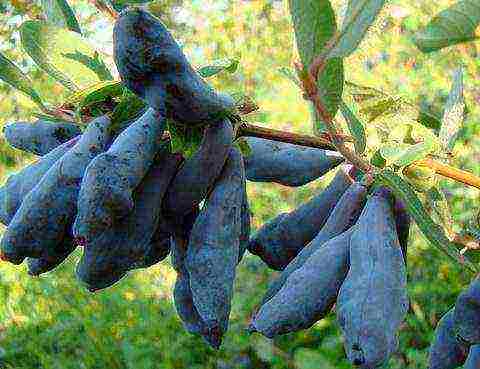
Honeysuckle variety Zagogulinka
The largest berries are in the Zagogulinka variety. Their average weight is 2.7 g, length is up to 5 cm. The berries have an elongated-curved shape with a thickening at the bottom. The skin is covered with bloom. The fruit has a pleasant taste, but with a slight bitterness. Ripening period - early, bushes - spreading. The fruits almost do not crumble, but they are easily removed from the branches.
Honeysuckle: sweet varieties
Gardeners have noticed that the fruits of any variety of honeysuckle become sweeter and lose notes of bitterness if the plants are watered abundantly from the moment the buds are formed until the berries are poured (after that, watering must be reduced). The sweetest varieties of honeysuckle: Silginka Roxana, Altair, Omega, Nymph, Souvenir.
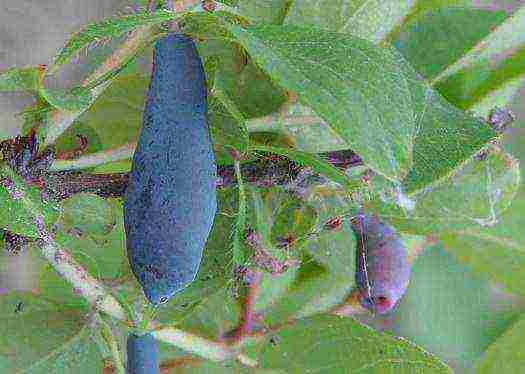
Honeysuckle variety Sibiryachka
The Sibiryachka variety is beyond any competition in terms of sweetness. It ripens early, withstands low temperatures well and has a high yield (up to 3.5 kg of berries from each bush). The berries hardly crumble. The height of the bush is average. Fruit weight - about 1.4 g, shape - fusiform, taste - dessert.
Decorative varieties of honeysuckle
In addition to varieties that produce edible fruits, there are also decorative varieties that are used to decorate the garden. In turn, they can be upright or curly. Popular decorative varieties and types: Golden, Alpine, fragrant Caprifol, Henry, Korolkov's honeysuckle, Maak's honeysuckle, etc. Many varieties of honeysuckle exude a pleasant aroma.
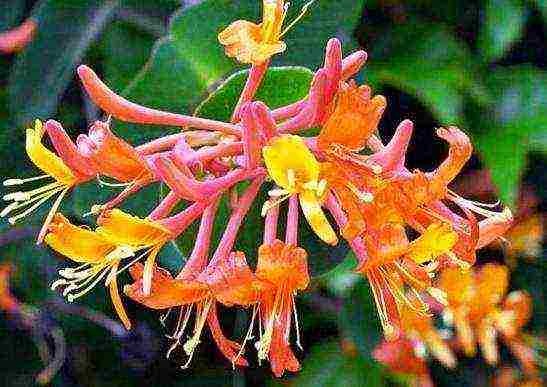
Brown's honeysuckle
Brown's honeysuckle looks very beautiful in the garden. According to its external characteristics, the plant is a compact, climbing, semi-evergreen liana. The leaves of the plant are colored bluish green. Bright tubular flowers bloom towards the end of summer. Ripe berries are colored red. The average height of the vine is 4 m. The plant needs shelter for the winter.
Honeysuckle is a useful plant that attracts attention not only for its beauty, but also for the taste of berries. A big plus is the varietal variety - everyone can choose the most successful variety, focusing on the climatic features of the region and on personal preferences.
The most suitable varieties of edible honeysuckle for growing
Similar articlesYes, this is important, because they pollinate each other and there will be more berries.
The benefits of garden honeysuckle
These varieties of honeysuckle are most suitable for the Moscow region, but you can plant a few more bushes, which are bred specifically for this region, give a high yield, are winter-hardy and unpretentious in care. Try other varieties: Morena, Amphora, Altair, etc. Plant, take care, and you will surely collect a magnificent berry harvest.
Spring work on the preparation of honeysuckle for fruiting will require the introduction of nitrogen fertilizers. Usually they take 30 g of ammonium nitrate or 20 g of urea per 1 m² of soil. It is necessary to apply fertilizers before and during the blooming of the honeysuckle buds.
To obtain a high-quality bush and a high yield of honeysuckle, you will need to comply with several prerequisites.
1,5
- Bright, with a bluish bloom, tasty berries without bitterness.
- 2
- 1
- Sorceress
Vasyugan - Tomichka;
What do we associate the word "berry" with? These are round, red, yellow, less often green, taste sweet or sweet and sour small fruits. The first to come to mind are raspberries, gooseberries, and strawberries. But, even in our gardens, you can grow berries that do not correspond to this idea at all - this is honeysuckle, a berry that has an irregular elongated shape, a bright blue color and a very unusual, complex and refined taste.
Several varieties of the same type - Altai Kamchatka and I forgot they bloom at different times and if there is no pair, then empty bushes will remain
How to grow garden honeysuckle?
Bakchar honeysuckle has the most delicious varieties. The sweetest varieties: Sibiryachka (out of competition), Silginka (second place) and Roxana (third place). These varieties are generally without a hill.
- In June, 15 g of double superphosphate and 10 g of ammonium nitrate per 1 m² are again introduced. At this time, honeysuckle produces fruit buds, reduces the growth rate of new shoots.
- The most preferred planting time is autumn. Honeysuckle manages to take root well, "get used" to the place in order to winter well. Spring planting is fraught with violation of the growing season, kidney damage and weakening of the bush.
- 0,9
- Zest
1-1,3
Medium ripening, the berries are bright blue with a strong waxy bloom and a very fresh taste without bitterness.
Up to 2
Pavlovskaya - Tomichka;
The best varieties of edible honeysuckle of domestic selection
Many gardeners are interested in what varieties of edible honeysuckle are most suitable for growing in our conditions. Below we will provide descriptions of the most interesting varieties of domestic and foreign selection that can be bought in garden centers and nurseries, as well as what kind of care they need to provide in the garden.
It is very important - self-infertile. 3 bushes of different varieties will give sufficient pollination - always wake up with the harvest. There are a lot of varieties now, and even if you choose one with a bitterness, do not be discouraged, they make the most delicious jam and compote: the bitterness goes away during heat treatment, and the taste is brighter.
| A very good variety, in terms of taste, from the already relatively old varieties - Morena. | You are determined to grow honeysuckle on your site, varieties for the Moscow region have undergone special selection and adaptation. Since 1950, purposeful work has been carried out in the Moscow Botanical Garden to develop a honeysuckle variety without bitterness in berries. Samples for this were brought from the Urals, the Far East and Siberia. Breeders A.K. Skvortsov and A.G. Kuklina managed to develop a new variety of titmouse honeysuckle. Its distinctive feature is stability and early ripening of berries. | | Bright blue, thin-skinned berries, the sweetest of all, no bitterness, late ripening. |
| 1,2-1,5 | Berries are sweet and sour, without bitterness, early. | Long-fruited | 1,2-1,3 |
| Blue Spindle - Blue Bird; | The first mentions of an unusual shrub with delicious blue berries were voiced by the Russian explorer Atlasov after his trip to Kamchatka at the end of the 17th century. Then it turned out that this berry is widespread and enjoys great love among the inhabitants of Altai, Sayan Mountains, Transbaikalia, Primorsky Territory. In those regions, honeysuckle is considered not only an excellent delicacy, but also a very effective healing agent. | Neighborhood. alas, it has no options | The blue spindle, which everyone advises, is not the best variety for my taste, I would not plant now. Compared to the above, it loses much in the taste of berries. Another drawback of the blue spindle variety is that it crumbles very much, if the berries are not picked in time, most of the harvest will end up on the ground. This is a very old variety of the Barnaul selection, in the state register since 1989, now there are much better varieties. |
| This is a vigorous shrub with a round crown, capable of growing under favorable conditions up to 2 m. The places are chosen for planting sunny, but this variety tolerates temporary shading well. The plant should be provided with regular watering, especially during the period of ovary of fruit buds. Berries with a strong aroma, completely devoid of bitterness, the taste is sweet and sour. The shape of the fruit is elongated, slightly oval. The length rarely exceeds 3 cm. The top of the berry resembles a saucer. The skin of the fruit is thin and tender. The titmouse honeysuckle variety has weak crumbling. | How to plant honeysuckle: | Chelyabinka | 1,5 |
| Bazhovskaya | 2 | Compact bush, early harvest, dessert taste. No bitterness. | Chelyabinka - Long-fruited. |
| The fruits of honeysuckle (only edible!) Are used for hypertension and cardiovascular diseases, internal bleeding. They have the ability to strengthen the walls of blood vessels, cleanse the gallbladder from sand and stones, and are also useful for gastrointestinal disorders and poisoning. Fresh berries, pounded with sugar and in the form of jam, act as an antipyretic agent. | The most delicious varieties of bakchar honeysuckle selection | Honeysuckle of any variety will be much sweeter, tastier, larger and without bitterness if watered abundantly during the period from buds to pouring berries. And during the ripening period, you no longer need to water unless absolutely necessary. | Honeysuckle Titmouse has one peculiarity. Do not be alarmed if a bark detachment occurs in a plant three years old. It slides down with a tape, exposing brown wood. |
| Saplings 2-3 years old are most preferred. They are quite strong and have a well-branched root. | 2 | Delicious, aromatic, berries without bitterness, do not crumble. | 2 |
| 1,5 | Viola | The ideal place for planting bushes is an open, sunny place, and the soil must be improved to a high level of fertility and moisture capacity. The easiest way to do this is by adding peat, leaf humus in large quantities to the planting pit. The bottom of the pit can be covered by 20-30 cm with dry grass and garden waste. | |
| The composition of edible honeysuckle berries is truly unique - it is a storehouse of the most important biologically active substances and vitamins. In particular, these berries are considered champions in terms of the content of P-active substances and vitamin C in an ideal ratio for the human body. Berries are an excellent antioxidant. | The most delicious and sweet varieties: Sibiryachka (the sweetest honeysuckle), Silginka (sweet with sourness), Roxana (sweet-sour taste, not sweet-sour, but sweet-sour, since it is more sweet). These varieties have practically no bitterness. | Honeysuckle can be cut with last year's and green cuttings, but it is best to cut it with green cuttings in the phase from the end of flowering to the ripening of the first berries. Then the rooting rate of cuttings is 80-90%. Cut into three buds, cut off the bottom 2 pairs of leaves, dip in korevin and plant in the ground somewhere in partial shade, cover with a piece of plastic bottle on top. Rooting begins to take place in 14 days. By autumn, it finally takes root and can be transplanted to a permanent place. However, it is better not to do this and wait with a transplant until next autumn, and also cover it for the winter, since it can freeze out in the first winter. | A new mid-early variety, which is recognized as the best for growing in the Moscow region. Honeysuckle variety Nymph has a low bush, with a rounded and lush crown. Branches are straight, brown. The berries are bluish-blue in color, with a thin waxy coating. The shape of the fruit is elongated, a bit like a spindle. The berry is rather large, weighing up to 1.16 g. The taste is pleasant, sweet with a strong aroma. |
| The distance between the bushes of honeysuckle is maintained when planting about 1.5 m. | 1.1 | Blueberry | 1,5-2 |
| The berries are long, bumpy, with an excellent taste. Ripening very early. | Up to 1.5 | Pits should be made at a distance of 1.5 meters from each other - this way you will provide ideal conditions for cross-pollination. After planting, you need to pour at least 1 bucket of water under each bush. | But, it would be wrong to say that the benefits are the main reason to rank this unique berry among the top 10. Edible honeysuckle also has a number of other great qualities: |
| Of the other varieties, I like Morena. Although now there are a lot of varieties and I don't know about everything anymore. | So I don't know what kind of honeysuckle I have, but it is sweet, blue and long in color when it ripens. Also dug up from a neighbor. But about Timiryazevka. A neighbor bought an apple tree there before budding, but it turned out to be a pear. I think it is better to “uncover” all the same, as experience shows it is always more reliable. | For a yield of the Titmouse variety, it is better to plant the Amphora variety honeysuckle nearby | Planting of 3-4 varieties will be required to ensure pollination. |
| Very good taste and berries do not crumble for a long time. Ripening - early August. | 2,5 | One of the best large-fruited varieties of medium ripening, dessert berries. | Swallow |
| 1 | Edible honeysuckle plants do not need to be pruned, as is customary with all shrubs, since pruning in honeysuckle delays growth and the beginning of fruiting. | Refined taste: sweet and sour, in some varieties - with a piquant bitterness, others without bitterness, high juiciness. | You need to plant at least two, and preferably three varieties. Honeysuckle is self-fertile and needs to have a pollinator. The taste and size of the berries of any variety of honeysuckle becomes much better if it is well watered during flowering, setting the fruit and pouring the berries. Then even the varieties with bitterness are quite tasty. I have 4 grades. This berry is the very first and very tasty! also very useful! |
| That's right, I have 3 different varieties nearby ... They have different ripening periods, consistent - first sweet, then sour, then bitter ... With a difference of about 2 weeks ... comfortable.. . and also - if you plant only one variety - there will be no berries. But what they are called - I do not know, I have forgotten. | Fruiting up to 25 years in Nymph honeysuckle, the description of the variety contains data on high resistance to frost and pests. | Examine the bush carefully. You must cut out damaged and broken branches and remove dry roots. Then you need to immerse the lower part of the honeysuckle in the earthen mash. | Foreign varieties of edible honeysuckle available to gardeners in our country are real masterpieces of selection. Among them, it should be noted such as George Bugnet, Marie Bugnet (Canada) - these are truly unique hybrids: the berries do not ripen simultaneously, but from June to August and do not crumble for several weeks. The German variety Amur and Blue-Gray (USA) is distinguished by long berries with a great taste, absolutely no bitterness. |
| Up to 1 | Lapis lazuli | Up to 1.5 | The most resistant variety to diseases and pests. Frost resistance up to - 48 C. Berries are sweet and sour, with bitterness. |
| Adult plants do not require annual pruning. It's just that every spring you need to remove dry, broken or interfering with harvesting branches growing inside the crown. For the rest, the conditions for growing this crop and caring for it are the same as those of black currant. | This is the earliest berry. In central Russia, it ripens in early June, in the southern regions - in mid-May, and in the north - in the second part of June. Today there are also late-ripening varieties, so fruiting can be extended almost until August. Care consists only in the timely collection of the crop. | Plant! You will not regret it! | |
All known varieties of honeysuckle are self-infertile, that is, fruit ovaries are not formed without cross-pollination. For a harvest, you must plant at least 3 different plant varieties on your site.
Honeysuckle varieties for the Moscow region
They lower the bush into the hole and straighten the roots, at the same time monitor the location of the root collar. It should be at ground level or 2 cm lower.
Honeysuckle is an adornment for any garden. Its flowers have an intoxicating aroma, and the berries have an unusual taste. The popularity of the plant grows every year and more and more often low bushes with small bluish-blue fruits appear in the gardens of the Moscow region. Honeysuckle is appreciated for its easy care, the ability to easily endure harsh winters and produce a stable harvest. The shrub is very hardy and resistant to recurrent frost during flowering. At a temperature of -5 ° C, the inflorescences remain on the bush and bear fruit well. This bush is a record holder! Just imagine that a plant is capable of bearing fruit up to a "respectable" age. Small berries can be plucked from a bush that is over 30 years old. Impressive?
How to choose a place, prepare the soil for planting
Flat fruits with excellent dessert taste, ripening in early July.
Up to 2.5
1-1,2
My joy
Planting honeysuckle
Officially in Russia, honeysuckle was added to the list of berry crops, oddly enough, only in 1956, and abroad even later. But during this time, more than a hundred large-fruited and high-yielding varieties have appeared, the planting of which will be appropriate in gardens and dachas. Interestingly, most of the names are associated with the color of the fruit: Dove, Azure, Blue Spindle, Blue Bird, Titmouse, etc.
The fruits can be consumed not only fresh - they are perfectly stored frozen, they can be dried, used for making compotes, juice, preserves, marmalades and jam. Wine of excellent taste is even made from these berries.
I have 5 honeysuckle bushes, I know for sure that there is a Blue Spindle - a good variety, Titmouse - serves more as a pollinator, but the berries are also tasty, they just are smaller, I don't remember the other varieties, tags in the country. But I don't have absolutely sour ones, all are sweetish. I really appreciate this beautiful berry.
-
- The root is buried in the ground and watered at the rate of 10 liters of water per one honeysuckle bush.
- There are known cases of fruiting of honeysuckle at the age of 150 years.
- Sinilga
- 2-2,2
- Very tasty berries, ripen early.
- 1,5-2
Proper care of the bush
Today, for amateur cultivation from Russian varieties of edible honeysuckle, the following can be called:
Edible honeysuckle is an unpretentious and durable plant. Lives and actively bears fruit up to 60-80 years. The shrub is very frost-resistant - it is not damaged even at temperatures down to -45 C.
Honeysuckle is a cross-pollinated plant and is not pollinated by its own pollen — it is self-fertile. You need at least two varieties. For a long time I had only two varieties — they were well pollinated. Yes, I agree — the most delicious Bakchar varieties — they are the latest achievements in breeding, large-fruited and very productive.
Chrenki is reliable But you need to plant at least three varieties, otherwise there will be no berries.
The bush is low, the crown is dense, squat. The fruits are sweet, fragrant, rather large. The berry mass reaches 1.1 g, the length is 2 cm. The shape of the fruit is oval, slightly elongated and pointed towards the apex. The skin of the berry is thin, the color is blue with a bloom. Honeysuckle Chosen is a late-ripening variety. The yield is high. Up to 3 kg of berries are harvested from one bush. The Chosen variety is characterized by the union of berries in pairs. It keeps well on the bush, does not crumble for a long time.
Honeysuckle varieties
The surface layer around the bush is sprinkled with mulch (peat, humus).
Titmouse variety
It is preferable to plant the plant in a bright, well-warmed place by the sun. Although, according to some gardeners, it develops well and weakly shaded places, for example, among tall fruit trees. Loamy, sandy loam soil is suitable. The main requirement is that there is no excess moisture or, conversely, too dry soil. Honeysuckle will develop poorly on acidic soils, poorly drained and heavy in texture. The close occurrence of groundwater (less than 1 m) is also highly undesirable. Pay attention to the openness of the site and the effect of the wind on it. In honeysuckle bushes, young leaves suffer from it, developing and already ripe fruits come off.
2
Variety Nymph
Very large tasty berry, ripening - July
Pushkinskaya
1,2
Variety name Fruiting of bushes begins at the age of three, care is simple, and the average yield is 1-3 kg per bush. Although some varieties, for example, Amur of German selection, under good conditions, gives up to 5 kg of rather large berries without bitterness.
Chosen variety
Honeysuckle needs to have several varieties bred on the same basis - for example, Kamchatka honeysuckle. she herself is not pollinated because the stamen and pistil mature in the flower at different times. therefore, a second and third grade is needed in which they also ripen at other times.cross-pollination occurs - honeysuckle Blue spindle Commonwealth. Pushkinskaya. Malvina
Nymph, Amphora.
Honeysuckle variety Chosen One is good for making desserts, homemade preparations and making wine.
Growing honeysuckle can be a pleasure. This is a "grateful" plant that always bears fruit and is rarely exposed to disease. You need to monitor the oxygenation of the root system. For this, surface loosening is carried out, no deeper than 10 cm, otherwise you risk damaging the root system. Remove weeds and sprinkle mulch over the bush area to provide sufficient moisture to the roots close to the surface. The minimum layer of humus, peat or other available organic matter is 4 cm. When using sawdust, it is necessary to apply nitrogen fertilizers (40 g per 1 m²). During the season, loosening and weeding are carried out 2 times. With the onset of autumn, the bite zone is carefully dug in. The soil must be prepared carefully. All weeds are removed, especially perennials. They can greatly weaken the planted honeysuckle. Fertilize the site by introducing organic matter. In the fall, 10 kg of manure, humus or prepared compost are dug up together with the soil. On 1 m² of land add 30 g of double superphosphate and potassium sulfate. For liming, you will need from 200 to 400 g of lime for each m².
About 1
Edible honeysuckle in Russia - video
What is the sweetest variety of honeysuckle? a neighbor has three bushes. sour, sweet and sour and sweet. sorts of it,
Sentient Dolphin
Malvina
1
Late grade, berries with bitterness, excellent grade for preparing blanks.
Yield per bush (kg)
The only drawback of this type of berries is that they ripen almost at the same time and immediately crumble. And their skin is very delicate and bursts even from the touch of a hand, therefore, when it hits the ground, most of the berries are damaged. For this reason, edible honeysuckle berries are not grown commercially, and breeders are not very fond of it. Almost all known varieties were bred by IV Michurin, who generally considered honeysuckle to be berry No. 1, or by amateur enthusiasts.
Natalya Thank you
Delicious variety Blue spindle Really needs several varieties for cross-pollination
coliri
In general, local gardeners have already noticed that the more you water the honeysuckle, the sweeter it is. Independent of the variety.
pevaly
You do not need to choose honeysuckle varieties for yourself with a photo, you should read the available information on the network or ask the garden center what will grow better in the Moscow Region.
Dina
If you want to get a high yield, take care of soil fertility. A well-prepared planting site will provide honeysuckle with useful substances for 2 years.
Olga
When planting in spring or summer, lack of organic matter, it is permissible to apply them directly to the pit or prepared trench. The dimensions of the recess for one honeysuckle bush are made about 60 cm wide, and the depth will be 50 cm. When planting in trenches, they are dug out of the same width and depth as the hole. Organic and mineral substances are introduced in the same proportions as when digging the earth in the fall (calculation for 1 hole or running meter of a trench).
Prokhor Kupriyanov
Late ripening, berries with a slight bitterness.
Natalia Solovieva
1,5
The fruits are early, cylindrical, sweet and sour, with a very pleasant aroma. Very frost-resistant variety.
which variety of honeysuckle produces the most delicious fruits?
Unknown Unknown
Altair
Weight of the 1st berry in grams
Tatyana Ivanova
By the way, in order to keep the berries intact during ripening, it is recommended to hang a thin net under the bush (you can use gauze) and lightly shake off the branches from time to time - ripe berries crumble. Or you need to collect them by hand and put them in a container, only 2-3 layers maximum.
Polina shubina
I have 5 bushes, plant this berry be sure.It's a pity I don't remember exactly my varieties, records at the dacha)) But they are really all different in taste and in the shape of the berries.
Alexey Losev
It is better to buy seedlings in nurseries or specials. stores. At least 3 bushes.
Sentient Dolphin
The bitterness of honeysuckle disappears in the jam
For 3 years, 10 kg of rotted manure or compost is brought under the bush during autumn digging. The introduction of organic matter will have to be done every third year of the plant's life. Mineral additives are added annually. In autumn, add 20 g of double superphosphate and potassium salt to each bush of honeysuckle or 1 m² of soil.
It is better to choose early autumn (September) for planting. If it is planted in spring, then this must be done before the first buds on the bush begin to open. Transplant in the summer should be only after the end of growth.
Slavyanka
1
Sineglazka
Irina Shabalina
About 1
Tina Ezdakova
Description of berries and taste, other characteristics
Olga
It is best to plant bushes in the second half of August or early autumn. Spring planting delays the onset of fruiting by another year, no matter what kind of care. Several specimens should be planted at the same time and preferably of different varieties. This is because this plant is cross-pollinated. If you plant only 1 bush, then the harvest can not wait. The best inter-pollinators are such pairs of domestic varieties:
Dina
I planted six different bushes, I think they will give berries for 3 years, but since it did not grow almost in the fall, I cut it off a little. Hope for a harvest. They say its roots develop for 3 years, then the bush grows and berries.
Just Pooh
Blue spindle
.
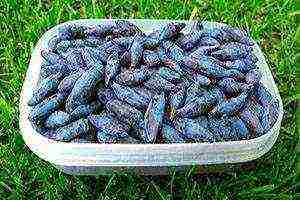
Often for landscape design, gardeners use different types of decorative honeysuckle. There are also varieties of sweet honeysuckle, with which you can not only ennoble your site, but also enjoy the taste of ripe sweet berries with a bright aroma. From the fruits, you can make winter supplies in the form of jam and compotes. In addition, honeysuckle has beneficial properties.
Honeysuckle is usually subdivided according to some criteria:
- ripening period;
- yield;
- taste;
- the size of the bush.
From the whole variety of this edible plant, you can choose a variety that suits you in terms of taste, and for your garden plot - in terms of decorativeness.
Note: Honeysuckle varieties will not bear fruit in full force, so several varieties need to be planted nearby so that they are pollinated.
Early maturing varieties of honeysuckle
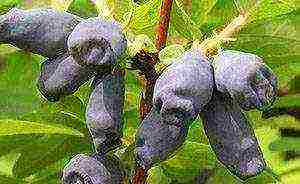
Kuminovka
Kuminovka Is a semi-spreading medium-sized plant. Early ripening, sweet taste, preferably fresh berries. Average yield, about 2.5 kg per bush per season.
Siberian. The size of the bush is medium in size. The ripening period is early: the ovaries appear already at the beginning of summer. The berries are sweet, can be used as a dessert with the addition of sour cream or cream. The yield is high, about 4 kg of berries can be harvested from one bush per season.
Cinderella - This is a short bush with thin shoots. An early ripening variety, honeysuckle begins to bloom in late spring. The fruits have a sour - sweet flavor, a berry with a characteristic strawberry flavor. The yield is high; from 2 to 3 kg of berries are harvested per season.
You need to know: fruits of "Cinderella" are famous for their healing properties due to the high content of trace elements and vitamins C, R.
Sweetheart - a low-growing plant with an oval crown. Ripens early, at the end of June, differs from other varieties with a strong aroma. From the name it is clear that the berries are very sweet. A large harvest can be harvested during the season.
Tatyana. It is characterized by a small bush with dense foliage. An early variety, blooms in late spring, fruits appear in mid-June. The berries are sweet, the largest of all honeysuckle varieties. You can collect up to 2.5 kg of fruit.
Hope - undersized bush, has not very dense foliage. An early ripening variety, already at the end of June you can enjoy delicious sweet berries.The yield of this variety is high, more than 2 kg of fruits per season.
Medium ripening honeysuckle varieties
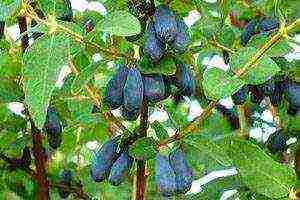
Cubic zirconia
Fire opal. The size of the plant is small with a spreading crown. It has a bitter taste, but it disappears when the berry is fully ripe. You can cook jam or grind with sugar. The yield is high, if honeysuckle is cultivated on a plot of 10 years, then it will be easy to collect 5-6 kg of berries, and in the first years - up to 3 kg.
Cubic zirconia differs in medium size, with flexible small shoots. The fruits begin to ripen in the middle of summer. This honeysuckle is perfect as a dessert. The yield is average, ripe berries can be harvested up to 2 kg.
Lapis lazuli - a small bush, branches pressed against each other. Average ripening period. Fruits with sweet large berries that are good both fresh and in compote. The yield is high - from 1.5 to 2.5 kg of fruits per season.
Vlada Is a tall bush with a dense dark green crown. Ripening period is average. The berries have a sweetish flavor. Pounded with sugar will be an excellent addition to tea drinking. The yield is above average, about 1.5 kg per plant.
Need to know: picking berries is difficult, the tender pulp immediately spreads, so it is better to use freshly picked fruits immediately.
Provincial - a low plant. The berries ripen in mid-summer and have a sweet taste with a creamy aroma. Due to the extended ripening, the yield is low.
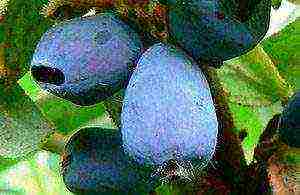
New
New - a low spherical bush. Ripening period is average. Ripening begins at the end of June. The taste of the berries is sour with a sweet undertone. The yield is very high - up to 6 kg of fruits. Vitamin C content is approximately 60%.
Lulia - medium-sized bush with soft shoots of light green color. Ripening period is average, it begins to bear fruit from the middle of summer. The taste of the fruit is sweetish without bitterness. Average yield, up to 2 kg of berries.
There is a good article on how
properly care for honeysuckle
.
If you are interested in what diseases and pests of honeysuckle are, and how to deal with them, then read a detailed article about this.
here
.
Shahinya - This is a medium-sized bush, the crown has an oval or conical shape. Ripening period is average. Berry taste with pronounced sourness without bitterness. The harvest is suitable for jams, juices, compotes. The yield is high.
Late-ripening honeysuckle
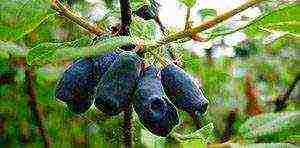
Gzhelka - the latest of all varieties of sweet honeysuckle. The berry has a tart sweetish taste. The yield is average.
If the shrub is planted in an open space, it can reach a height of 2 m, and if in a densely populated area, then the plant will be undersized.
Interesting: "Gzhelka" can also be used as an ornamental plant: the large green leaves of this variety are the best suited for hedges.
Why are the fruits of honeysuckle bitter
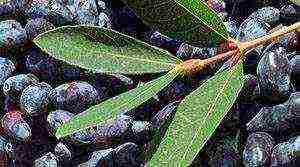
Summer residents are upset if the fruits of sweet honeysuckle begin to taste bitter, even if a variety with sweet berries was purchased.
This is mainly due to improper plant care. By adhering to several rules, you can harvest a large harvest with an excellent taste of berries:
- choosing a suitable landing site (it is better to choose partial shade);
- abundant watering, especially during the flowering period (good drainage must be ensured so that the water does not stagnate);
- remove dry branches and shorten last year's.
Please note: ripe berries fall off easily, so when harvesting, lay some light-colored material, such as a covering material, on the ground around the honeysuckle.
We suggest you watch a video on how to grow sweet honeysuckle:
Rate the article
(
estimates, average:
out of 5)
